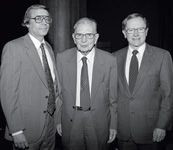News
Article
Jules Stein Eye Institute turns 40, plans expansion
Los Angeles-As the Jules Stein Eye Institute (JSEI) celebrates 40 years of contributions to research, education, and patient care this month, construction is approaching for a major new building that will help carry the institution into future decades.
Los Angeles-As the Jules Stein Eye Institute (JSEI) celebrates 40 years of contributions to research, education, and patient care this month, construction is approaching for a major new building that will help carry the institution into future decades.
The Edie and Lew Wasserman Eye Research Center, on which work is expected to begin in 2007, will add about 100,000 square feet of space to the 175,000 square feet of the

Figure 1 University of California, Los Angeles (UCLA) ophthalmology leaders are (from left): Bartly Mondino, MD, JSEI director and UCLA chief of ophthalmology, 1994 to present; S. Rodman Irvine, MD, acting chief of ophthalmology, UCLA, 1955 to 1958, and Bradley Straatsma, MD, JSEI founding director, 1964 to 1993, and UCLA chief of ophthalmology, 1959 to 1993. (Photo by Charlie Martin/UCLA
institute's current campus at the University of California, Los Angeles (UCLA). The capital portion of the project is being funded through the Wasserman Foundation, the Stein estate, and the Jules and Doris Stein UCLA Support Group.
"It not only will allow us to expand our existing faculty and programs but will allow us to create revolutionary new programs in the way we treat and cure blindness," said Bartly Mondino, MD, who has directed the institute since 1994. "It will house facilities for research and operating rooms, including the possibility of gene therapy."
Nov. 3 marked the 40th anniversary of the dedication of the institute's original 88,000-square-foot structure, some of which was finished internally in the 1970s. By the 1980s, the institute had increased in size by 20,000 square feet by expanding into an adjoining parking garage. The 1989 opening of the Doris Stein Eye Research Center building added 67,000 square feet to the institute's complex. The planned edifice is named in honor of the late Lew Wasserman, a former trustee of the institute, and his wife, both longtime supporters. It will replace an existing structure of the UCLA Medical Center. The JSEI is one of the youngest eye centers in the United States, and Bradley Straatsma, MD, has been there from the beginning.
"It was a very exciting time," said Dr. Straatsma, who joined the UCLA ophthalmology faculty in 1959 and was named founding director of the institute in 1964, when it formally was established by the University of California (UC) Board of Regents. He served through 1993.
"We were extremely fortunate in attracting the interest of Dr. and Mrs. Jules Stein . . . and, through them, many other philanthropists in the community of Los Angeles. We also had a receptive environment at the University of California," he said.
Dr. Stein was a skilled ophthalmologist and musician who left practice to found Music Corporation of America, which later became known simply as MCA, explained Dr. Straatsma, also professor and chairman emeritus of ophthalmology at UCLA.
"He [later] returned to ophthalmology as a philanthropist," he said, adding that Wasserman succeeded Dr. Stein as chairman of MCA.
Over the years, said Dr. Mondino, the institute has added faculty and laboratories and has experienced an increase in patient visits and surgeries performed. Today, he said, JSEI faculty manages more than 80,000 outpatient visits, perform about 8,000 surgeries, and have research contracts and grants totaling about $8 million per year.
Of note in the clinical arena, the director said, in addition to the increase in the number of surgeries and outpatient visits, is the number of programs helping the underserved of Los Angeles.
"For example, our residents, fellows, and faculty practice ophthalmology at four affiliated hospitals," said Dr. Mondino, who also is chairman of ophthalmology at UCLA. "In addition, we have a mobile eye clinic that provides screening examinations for children and the elderly throughout the Los Angeles area free of charge. We have programs whereby indigent families and children can have surgery here at the Jules Stein Eye Institute. These programs are supported by philanthropic organizations. In addition, we have a preschool vision screening program and an in-school educational program for children, both of which are very important."
In the research arena, the expert in corneal external disease noted several accomplishments over the past decades (Jules Stein Eye Institute milestones in research). "All of our divisions have contributed a lot of important work," he said.
The next generation
In the area of education, Dr. Mondino said he is particularly proud of the institute's strong residency and fellowship programs, including the EyeSTAR program wherein a physician with an MD may complete a residency in ophthalmology as well as a PhD or postdoctoral work in vision science. "Graduates of this program are very able to apply for grants and get involved in vision science right away," he said. International graduates of the fellowship program, he added, often return to their countries of origin, where they achieve prominence in medical centers.
Dr. Straatsma said that the institute's success has come from the ability to balance three longstanding missions. "The care to people in the community, research, and education were very much a part of it from day one," he said.
Looking back, the specialist in retinal diseases and ocular oncology said, "Our field has advanced at an extraordinary rate, and I believe this will continue, because we're now in the era of molecular biology, genomics, immunology, and increasingly sophisticated technology."
As one example of the changes in vision care since the founding of the institute, Dr. Straatsma noted the transformation of cataract surgery.
"It's the most common operation that has been performed over the years," he said. "At the beginning of the institute, this was a procedure that involved inpatient care, and patients either had to wear a contact lens or use a very thick and vision-distorting eyeglass. Currently, it is an outpatient procedure done under local, sometimes topical, anesthesia, combined with an IOL that is often multifocal in its potential, and not associated with significant disability or difficulty for the patient.
"This is an enormous change, but the change occurred in everything else," he added. "It's occurred in retinal disease, pediatric disease, neuro-ophthalmology, and in the way we take care of the cornea and external ocular diseases as well."
Now, as the institute prepares for the future, Dr. Straatsma said the new building will serve it well.
"Organizations either go forward or they have a risk of becoming less effective," he said.
Newsletter
Don’t miss out—get Ophthalmology Times updates on the latest clinical advancements and expert interviews, straight to your inbox.




